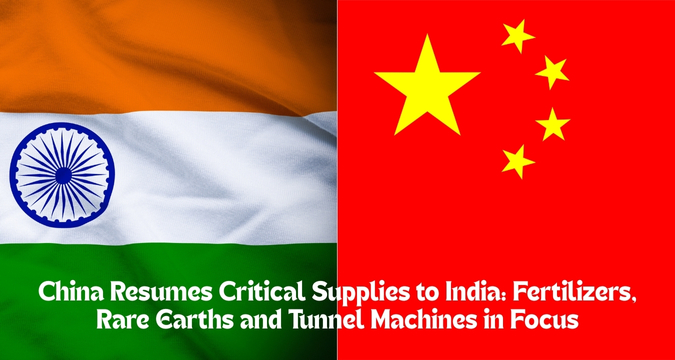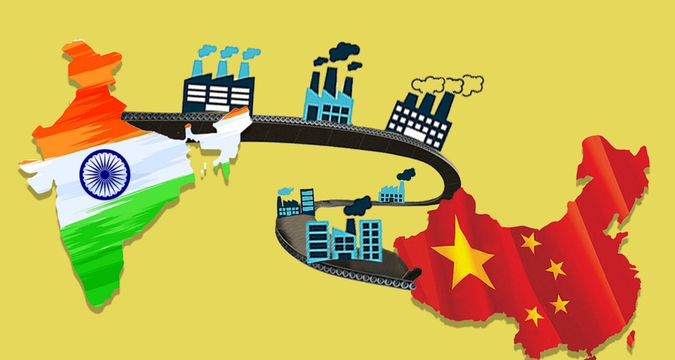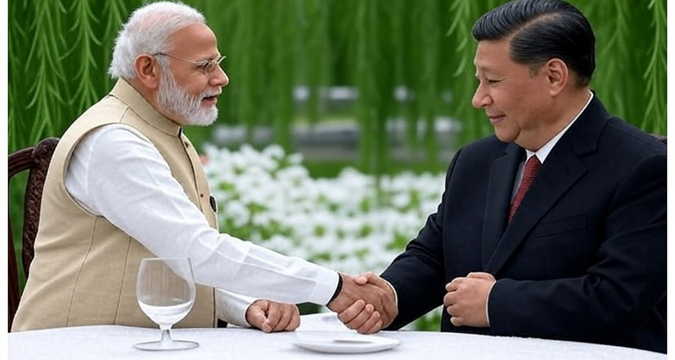In a major breakthrough that represents a cautious détente in bilateral economic relations, China will restart export of fertilizers, rare earth minerals, and tunnel boring machines (TBMs) to India following almost a yearlong ban on exports. The announcement came after a meeting in New Delhi between India and the Chinese Foreign Minister Wang Yi, who is on a two day visit as an attempt to restart high-level political dialogue.
The ruling has great implications especially on the agriculture sector, local manufacturing business and major infrastructure developments in India. Although border tensions will be addressed subsequently by the National Security Adviser at the bilateral level in a format (Special Representatives or SR mechanism), the new development indicates a serious desire on both sides to separate key bilateral trade interests with geopolitical issues.

Why This Development Is More Than a Trade Resumption
Although an economic choice, the renewed supplies of fertilizer and minerals on the surface is a unilateral move on the part of Beijing and New Delhi when the global chessboard is in the process of realignment with the renewal of fertilizers and minerals.
1. The Unspoken Strategic Triangle – India, China, United States
To both countries, the United States has now become the determining factor in calculating their national security calculations:
| Country | Present Strategic Concern |
| China | Growing US alliances in Indo-Pacific (QUAD, AUKUS), increasing technology sanctions |
| India | Rising protectionism in Washington, uncertainty in US tariff/visa policy (especially under Trump doctrine) |
Both capitals now understand that tension both with the US and between them simultaneously would allow no strategic flexibility. The move to strengthen economic relationships does not imply that trust has been restored, rather, it is because none wants to face two enemies at the same time.
2. A Tactical Pause, Not a Reset
The reader has to realize this is not a reset in the classical meaning. No new agreements had been signed, no formal joint statement was adopted and no road-map outlined on the resolving of legacy disputes. This tends to fall, in diplomacy, to be termed a functional détente:
On some fundamental areas we differ but opt to work jointly on matters that are of great mutual importance.
Some such functional détente examples in history are:
- The example of US-Soviet wheat trade during the 1970s, even during the Cold War (1972)
- Maintenance of Japan/China rare-earth business over past Senkaku/Diaoyu tensions
- India and China are now coming into that trend.
3. The Economics of Vulnerability – India’s Import Dependence in Numbers
| Sector | Current Domestic Capacity | Estimated Annual Shortfall |
| Fertilizer (Urea, DAP, NPK) | ~35 million tonnes | 7–9 million tonnes |
| Rare Earths | Early-stage exploration; no commercial-scale separation facilities | ~2,500–3,000 tonnes of finished RE oxides |
| TBM Manufacturing | <10 domestically made units per year | >35 units required annually |
This is the well-known strategic weakness of India that must be imported to keep the sector stable today.
Meanwhile, Beijing is also in need of large volumes of exports in the face of a weakening domestic economy. So, interdependence is strong on either side and economic suffering has led to short-time cooperation.
4. What India Gains in the Immediate Term
- Stability in supply before the following crop season which decreases inflationary risks on agricultural inputs.
- Prevention of delays in project implementations National Infrastructure Pipeline (NIP) targets, which also involves political values in light of the forthcoming state elections.
- Minimal reliance on emergency-sourcing which involves third world countries whose cost increases government spending.
- Early commitment to speed up programmed of self-reliance in REE, fertilizer and TBM production.
5. What China Gains
- One more obvious illustration to the United States of Beijing still having a say in South Asia.
- A pressure point in future talks is the creation of a new pressure lever – when supply has restarted, it can be put back in the basket once again should relations sour.
- A chance to establish an economic goodwill, whilst not relinquishing its fundamental political demands on the LAC.

The Key Risk: Weaponization of Supply Chains
A sufficient reminder to India is that during a geopolitical crisis, critical supplies are easily weaponized.
This has already been observed in the world:
| Case | Commodity | Action Taken |
| Russia–Europe (2022–23) | Gas | Supply halted |
| Australia–China (2020) | Coal, wine | Chinese blockade |
| Japan–China (2010) | Rare Earths | Exports frozen during maritime dispute |
This is exactly why New Delhi is intensifying the process of diversifying supply and investing in capability-building at home:
- Rare earth processing plants in Andhra / thrill / Odisha
- New TBM manufacturing facilities and plants at the BHEL (Haridwar) and the L&T (Hazira)
- Joint ventures on fertilizers with Morocco, Saudi Arabia and Oman
Why China’s Assurances Matter
China is still a main supplier in some major sectors of India:
| Commodity | Chinese Share in India’s Imports | Critical Use in India |
| Urea / NPK / DAP | ~30% | Agriculture & Food Security |
| Rare Earth Elements | ~25–28% | Auto-Components, Electronics, Defense |
| Tunnel Boring Machines | ~35–40% | Metro Projects, Road / Rail Tunnels |
Following the Galwan clashes of 2020 and a year of military confrontations in the Line of Actual Control (LAC) that followed, Chinese had incrementally restricted approval of exports to India, specifically in these high-sensitivity categories. A return to supply alleviates one of the chief bottlenecks and reassures the policy apparatus that imminent shortages are not of ultimate concern.
Diplomatic Context and Broader Signaling
In the meetings on Monday, Dr. Jaishankar reaffirmed in a very articulate manner the longstanding Indian policy on the One China policy and on issues related to Taiwan-stating categorically that India was, and continues to deal with Taipei only on the economic and cultural front and that it has no change of any type in position or statement on the issue.
Remarkably, the evolving security dynamic in the Indo-Pacific was acknowledged by both sides, but the United States the unwritten context of the discussion, especially within the policy framework of the Trump era. Responding officials to the meeting affirmed that the changing US-China and US-India equations was tacitly recognized as a reason both nations had to retain orderly bilateral communications channels.
At the diplomatic level, the fact that Beijing is returning to being an important export channel means it is attempting to reduce points of friction and rebuild a tangible working relation, without core political aspects getting worked out.

What This Means for India’s Economy
- Agriculture
Fertilizer usage was traditionally high during the kharif season in India, and the issue with imports had made India resort to emergency tenders with non-traditional sources (Oman, Saudi Arabia, Morocco). Reinstatement of the Chinese supplies will stabilize the incoming deliveries, release cost pressures and alleviate subsidy burden on the state.
- Industrial Manufacturing
The rare earth elements, such as neodymium, lanthanum, and cerium, are critical to building the auto-component industry, permanent magnets to EV manufacturing, advanced electronics, and perhaps even missile guidance systems. Though India has started working on alternative supply chains, the reliance in the near future will still be strong.
- Infrastructure
There are over 18 key metro construction packages and 26 road tunnel schemes that currently rely on Tunnel Boring Machines purchased from Chinese manufacturers. Without such supplies, EPC contractors had reported overruns and scheduled slippages. A relief will be given to Mumbai projects, the projects in Bengaluru, Chennai, Visakhapatnam and the Zojila Pass tunnel as it is going to be resumed on time.
Strategic Calculations Behind the Move
Several underlying factors may have influenced China’s decision:
| Factor | Impact |
| US (Trump) policy uncertainty | Aligns India and China on need for independent decision-space |
| Economic slowdown in China | Need to revive export-driven sectors |
| Limited success of India’s import diversification efforts | Creates space for mutually beneficial re-engagement |
| Desire to separate economic ties from border tensions | Practical channel to stabilise wider bilateral relationship |
The Road Ahead: Key Issues Still Unresolved
Although the most recent result is encouraging beyond doubt, analysts warn against its implication as a drastic change of strategic direction.
The militarized confrontation in eastern Ladakh is ongoing, and the withdrawal of forward deployments is not progressing yet. A further dialogue between National Security Adviser Ajit Doval and his Chinese A-side counterpart, Wang Yi, under the SR-level dialogue is likely to be confined solely to the LAC and no modalities of troop disengagement. The result of those negotiations will be more decisive in a long-term direction.
Meanwhile, India is following a multi-track approach, which encompasses:
- Increasing national self-sufficiency in fertilizer (Talcher, Gorakhpur urea plants);
- Accelerating rare-earth mining plans in the Department of Atomic Energy and IREL;
- Increasing sourcing of TBMs to Germany, Japan and France;
- Strengthening supply chain resilience by Critical and Emerging Technology (CET) program of the QUAD.
Conclusion: A Calculated Step Towards Normalisation
The Chinese move to de-restriction and restart the provision of fertilizers, rare earths and tunnel machines should be considered as a calculated measure to the resumption of normal engagement in relations to the economy- without solving the deeper-rooted geopolitical problems.
In the case of India, it has provided immediate relief on the economic and industrial level especially when the country is being pulled through the choppy waters of an industrialized world where domestic growth is being tackled at a breakneck speed.
It will be determined in the coming weeks whether the little economic détente can set the stage toward wider de-escalation. At this point, the message is loud and clear: even under the heavy competition of strategic rivalry, pragmatism seems to preserve its role in the relationships between India and China.







